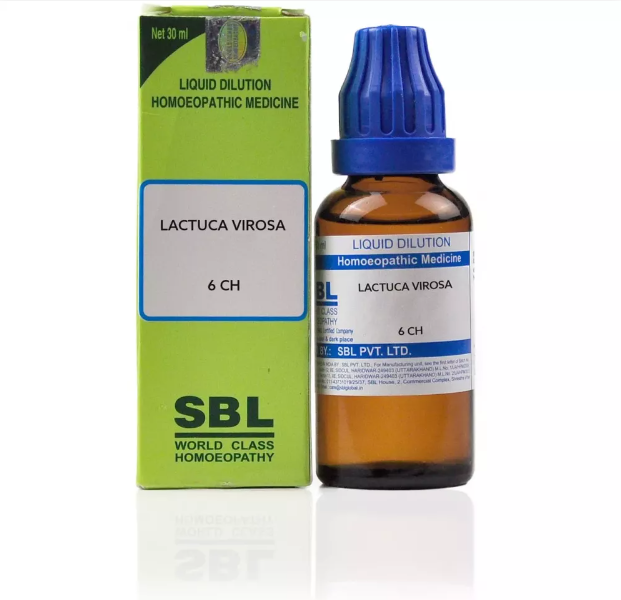LACTUCA VIROSA Q, 6C, 12C, 30C, 200C, 1M, 10M USES AND SYMPTOMS
 LACTUCA VIROSA
LACTUCA VIROSA
(Acrid Lettuce)
Lact.
This remedy primarily affects the brain and circulatory system. It addresses delirium tremens with symptoms like sleeplessness, coldness, and tremor. It is also used for hydrothorax, ascites, and impotence. Patients may experience a sensation of lightness and tightness throughout the body, especially in the chest. It acts as a galactagogue and has significant effects on the extremities.
Mind: Sense of stupefaction. Great restlessness.
Head: Dull, heavy, confused, dizzy feeling. Heat in the face and headache, with general coldness. Headache with respiratory system issues.
Abdomen: Sensation of weight and fullness; borborygmi; abundant emissions of wind. Colic in the early morning, with tense abdomen, relieved by evacuation and passing wind.
Female: Promotes menstruation. Increases milk in breasts (Asaf.).
Chest: Difficult breathing (asthma). Suffocative breathing due to chest dropsy (hydrothorax). Constant tickling cough. Incessant, spasmodic cough, as if the chest would burst (bronchitis). Squeezing sensation in the lower chest (angina pectoris).
Extremities: Lame hip, down the left side; worse when walking. Coldness and numbness in feet and legs. Tremor in hands and arms. Cramps in shin bones, extending to toes and side of leg, involving the calves.
Sleep: Restless; unable to sleep. Deep, comatose sleep.
Relationship:
Antidotes: Acet-ac., Coff
Compare: Nabalus serpentarius, Prenanthes serpentaria, Rattlesnake root, White lettuce (similar to Lactuca: chronic diarrhea, worse after eating, at night and towards morning; abdominal and rectal pain; emaciation; constipation and somnolence; sensitivity to others’ aura; dyspepsia with acid burning eructation; craving for acidic food; leucorrhea with uterine throbbing); Lach., Kali-c., Spira. (galactagogue).
Dose: Tincture.
SYMPTOMS OF LACTUCA VIROSA
Mind:
Stupefaction of senses
Great restlessness
Head:
Dull, heavy, confused, dizzy feeling
Heat of face and headache with general coldness
Headache linked to respiratory issues
Abdomen:
Sensation of weight and fullness
Borborygmi with abundant emissions of wind
Colic in the early morning, relieved by evacuation and passing of wind
Female:
Promotes menstruation
Increases milk production in breasts (similar to Asaf.)
Chest:
Difficult breathing (asthma)
Suffocative breathing from chest dropsy (hydrothorax)
Constant tickling cough
Incessant, spasmodic cough (bronchitis)
Squeezing sensation in lower chest (angina pectoris)
Extremities:
Lame hip, especially down the left side, worse with walking
Coldness and numbness in feet and legs
Tremor in hands and arms
Cramps in shin bones extending to toes and sides of legs involving calves
Sleep:
Restless and difficult to sleep
Deep, comatose sleep
selection of the potency
Individualization:
- Homeopathy is based on the principle of treating the individual, not just the disease. The unique symptoms and characteristics of the person are crucial in determining the most suitable potency.
Intensity of Symptoms:
- The intensity of the symptoms guides the choice of potency. If the symptoms are intense and acute, a lower potency (e.g., 6C, 30C) might be considered. For chronic conditions with less intensity, higher potencies (e.g., 200C, 1M) may be appropriate.
Sensitivity of the Patient:
- Some individuals are more sensitive to homeopathic remedies, while others may require higher potencies. The practitioner considers the patient’s sensitivity when selecting the potency.
Acute vs. Chronic Conditions:
- Lower potencies are often used for acute conditions, while higher potencies may be considered for chronic or long-standing issues.
Previous Response to Potencies:
- The patient’s response to previous homeopathic treatments helps guide the choice of potency. If a particular potency has been effective in the past, it may be repeated or adjusted as needed.
Vital Force and Susceptibility:
- Homeopathy views illness as a disturbance in the vital force. The practitioner assesses the patient’s overall vitality and susceptibility to determine the appropriate potency.
Aggravation or Amelioration:
- The direction of the symptom response (aggravation or amelioration) after taking a remedy can influence the choice of potency.
Miasmatic Considerations:
- In classical homeopathy, the concept of miasms (inherited disease tendencies) is considered. The practitioner take this into account when selecting the potency.
Practitioner Experience:
- The experience and preference of the homeopathic practitioner play a role. Some practitioners may have success with certain potencies based on their clinical experience.
SAFETY INFORMATION
- Do not exceed the recommended dose by physician
- Keep out of the reach of children
- Store in a cool dry place away from direct sunlight
- Maintain half an hour gap between food/drink/any other medicines and homoeopathic medicine
- Avoid any strong smell in the mouth while taking medicine e.g. camphor, garlic, onion, coffee, hing
Medicine images use for reference only selection of homeopathic medicine depends on the individual’s specific symptoms and overall constitution. Moreover, homeopathy is a holistic system of medicine that treats the individual as a whole. In addition to addressing the physical symptoms, it takes into account the emotional and mental state of the person. Consequently, it’s crucial to consult with a qualified homeopathic practitioner for personalized treatment.
The information provided on this website is intended solely for educational purposes. Always seek the advice of your physician or other qualified health provider.
